
Homeless Response Systems Mapping
What’s
at Stake
In 2020, over 580,000 people in the United States experienced homelessness on a single night (U.S. Department of Housing and Urban Development, 2020). Unfortunately, related services networks do not have enough resources to help all people experiencing or at risk of homelessness.
Some health issues are more common among people experiencing homelessness. They include:
- Mental and substance use disorders, which are found disproportionately more often in LGBTQ+ and Black youth (Fraser et al., 2019; Narendorf, 2017)
- Trauma, adverse childhood experiences, and victimization (Phipps et al., 2019; Kim et al., 2018).
Our Solution
The Homeless Response Systems Mapping is a targeted mapping event. It focuses on identifying and developing community-based responses to homelessness. The mapping does this by planning around critical intersections. The right supports and services at the right time can help prevent homelessness, or connect people experiencing homelessness with stable, safe housing. It takes collaboration to achieve this kind of support. State and local governments must coordinate their work with local non-profits and community organizations. Working together allows them to reach essential goals, including:
- Stabilizing housing for those at risk of homelessness
- Connecting individuals and families experiencing homelessness with services
- Helping people move from using homeless services to living in appropriate and safe permanent housing.
The Homeless Response Systems Mapping helps participants make a plan aimed at these targets.
Our Model
The Homeless Response Systems Mapping was developed by Policy Research Associates. Its purpose is to help people think concretely about how individuals experience homelessness and move to recovery. The model allows communities to see how individuals interact with homeless services and highlights paths to safe, permanent housing.
As part of a cross-systems mapping event, facilitators will:
- Conduct research and collect data from the community to identify who is experiencing homelessness and why;
- Interview key stakeholders who work with and know the network, from individuals providing services to the people in charge;
- Create a map of the four points of intersection that defines existing resources and gaps; and
- Integrate a discussion of solutions for the identified gaps and needs.
The Homeless Systems Map model highlights four points of intersection. They are prevention/diversion, pathways in, conditions of homelessness, and pathways out. In addition, a variety of wraparound services intersect with each point.
- Prevention/Diversion: Prevention and diversion programs aim to stop homelessness before it happens. They identify people and families before they start using homeless services and provide help. Programs at this intersection also offer alternatives to mainstream homeless services. Overall, they work to prevent individuals and families from losing housing.
- Pathways In: Individuals and families enter the homeless service system due to a wide range of circumstances. Common reasons include job loss, unexpected medical bills, and a mental health crisis. Other common reasons are family separation and exiting the foster-care system.
- Conditions of Homelessness: There is no one way to define homelessness. Definitions vary among federal agencies, funding sources, and age groups. Whether or not people and families qualify for services often depends on whether they fit the provider’s definition. This makes it very important to know which definition service providers use. When you know who qualifies, it helps provide a smoother transition of care between agencies and services.
- Pathways Out: The pathways out of homelessness are as diverse as the pathways into homelessness. To understand how this works in your area, it is key to collect information about outcomes. Specific metrics help show how local homeless service networks are doing. One metric many communities track is the length of time people spend experiencing homelessness. Others are the number of exits to permanent housing and return to homelessness.
- Wraparound Services: Services are key to ongoing housing stability for many individuals and families. Wraparound services provide help at every stage, from the earliest prevention work to pathways out of homelessness.

Stakeholders
The stakeholders involved in the Homeless Response Systems Mapping may include the following:
- Behavioral health and physical health services, including clinicians, caseworkers, peer specialists, physicians, and psychologists
- Education professionals, including school administrators, school psychologists, social workers, and homeless liaisons
- Employment services professionals, including employment specialists and benefit planners
- Homelessness services professionals, including outreach workers and people who have lived experience of homelessness
- Housing providers, including housing authorities, affordable housing developers, and permanent supportive housing operators
- Peers and family advocates
- Funders, such as grantmakers and program developers
- Legal services professionals, including pro-bono attorneys
- Social services professionals such as program directors and caseworkers
- Representatives from populations of interest, as determined by the community (e.g., people who are justice involved, Native communities, transition-age youth)
Case Studies
The Washington State Health Care Authority brought Policy Research Associates in to examine the state’s homeless network. This Homeless Response Systems Mapping provided a broader look at state-level resources and gaps across the four points of intersection. Stakeholders will use the map to help orient and train staff who are new to the homeless service system. Because of COVID-19, Policy Research Associates ran the mapping virtually. The remote work included data collection and key stakeholder interviews. View the Washington State Homeless Systems Map.
Follow-Up Assistance
Follow-up technical help is not always needed after your systems mapping event. But some jurisdictions find additional assistance useful. Further assistance could include strategic planning. It could focus on developing a list of priorities based on identified gaps. Or it could support creating an action plan to implement top priorities. If your community wants more support, the Systems Mapping Center is here. The Center can host follow-up meetings, give guidance and resources, or connect you with topic experts. These follow-up opportunities are offered on a fee-for-service basis if the need comes up.

